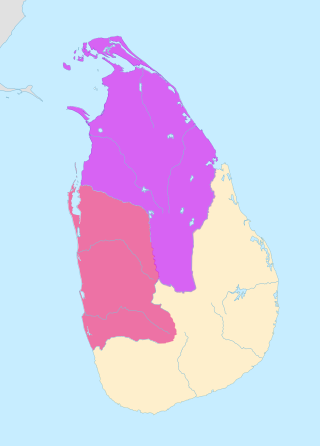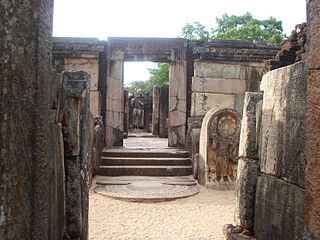
Lilavati was the fourth woman in Sri Lankan history to rule as sovereign in her own right. Lilavati rose to prominence as the wife of Parakramabahu I, king of the Kingdom of Polonnaruwa. Being of royal descent herself, she then ruled as sole monarch on three occasions in the near-anarchy following Parakramabahu's death, with the backing of various generals. The primary source for her life is the Culavamsa, specifically chapter LXXX.
Kalinga Magha or Gangaraja Kalinga Vijayabahu was an invader from the Kingdom of Kalinga who usurped the throne from Parakrama Pandyan II of Polonnaruwa in 1215. A massive migration followed of Sinhalese people to the south and west of Sri Lanka, and into the mountainous interior, as they attempted to escape his power. Magha was the last ruler to have his seat in the traditional northern seat of native power on the island, known as Rajarata; so comprehensive was his destruction of Sinhalese power in the north that all of the successor kingdoms to Rajarata existed primarily in the south of the island.

Parākramabāhu I, or Parakramabahu the Great, was the king of Polonnaruwa from 1153 to 1186. He oversaw the expansion and beautification of his capital, constructed extensive irrigation systems, reorganised the country's army, reformed Buddhist practices, encouraged the arts and undertook military campaigns in South India and Burma. The adage, "Not even a drop of water that comes from the rain must flow into the ocean without being made useful to man" is one of his most famous utterances."

The Kingdom of Polonnaruwa was the Sinhalese kingdom that expanded across the island of Sri Lanka and several overseas territories, from 1070 until 1232. The kingdom started expanding its overseas authority during the reign of Parakramabahu the Great.

Nissanka Malla, also known as Keerti Nissanka and Kalinga Lokesvara was a king of Polonnaruwa who ruled the country from 1187 to 1196. He is known for his architectural constructions such as the Nissanka Lata Mandapaya, Hatadage and Rankot Vihara, as well as for the refurbishment of old temples and irrigation tanks.

The Polonnaruwa Vatadage is an ancient structure dating back to the Kingdom of Polonnaruwa of Sri Lanka. It is believed to have been built during the reign of Parakramabahu I to hold the Relic of the tooth of the Buddha or during the reign of Nissanka Malla of Polonnaruwa to hold the alms bowl used by the Buddha. Both these venerated relics would have given the structure a great significance and importance at the time. Located within the ancient city of Polonnaruwa, it is the best preserved example of a vatadage in the country, and has been described as the "ultimate development" of this type of architecture. Abandoned for several centuries, excavation work at the Polonnaruwa Vatadage began in 1903.

Rankoth Vehera is a stupa located in the ancient city of Polonnaruwa in Sri Lanka. The stupa was built by Nissanka Malla of Polonnaruwa, who ruled the country from 1187 to 1196. The Rankoth Vehera has been built according to the tradition of the stupas of the Anuradhapura Maha Viharaya and bears a close resemblance to Ruwanwelisaya. In fact, a stone inscription situated close to the stupa even identifies it by the name "Ruwanweli". However, it has later come to be known by the currently used name, Rankoth Vehera. In Sinhalese, ran means gold, kotha is the name given to the pinnacle of a stupa, and vehera means stupa or temple. Thus, the name Rankoth Vehera can be roughly translated to English as "Gold Pinnacled Stupa". Along with the Kiri Vehera, it is one of the most revered stupas in Polonnaruwa.

Nissanka Latha Mandapaya is a unique structure in the ancient city of Polonnaruwa in Sri Lanka. A màndapa is a pillared structure that is open on all sides and protects the person(s) inside from the sun with a roof. By definition, as of the 20th century, mándapas, as temporary structures, are built inside a house or a building and serve as recitation platform during remembrance ceremonies for the dead.

Hatadage is an ancient relic shrine in the city of Polonnaruwa, Sri Lanka. It was built by King Nissanka Malla, and had been used to keep the Relic of the tooth of the Buddha. The Hatadage had been built using stone, brick and wood, although only parts of the brick and stone walls now remain. It appears to have been a two-storey structure, but the upper storey has now been destroyed. Three Buddha statues carved out of granite rock are located within a chamber of the shrine.
Mahinda VI (?–1187) was a king of the Kingdom of Polonnaruwa who came to the throne by killing his predecessor Vijayabahu II. He only reigned for five days, being killed by his successor and Vijayabahu II's sub-king, Nissanka Malla.
Vira Bahu I (1196) was son of Nissanka Malla and king of the Kingdom of Polonnaruwa, in present-day Sri Lanka. He came to the throne after his father's death, however only managed to reign for less than a day, being crowned at night and slain at dawn by the commander-in-chief of the army, Tavuru Senevirat on the grounds that he was a son not equal to his father.
Parakrama Pandyan II, also Pandu Parakramabahu of Polonnaruwa or Parakrama Pandu, was a Pandyan king who invaded the Kingdom of Polonnaruwa in the thirteenth century and ruled from 1212 to 1215 CE. His namesake royal Parakrama Pandyan I had ruled in Madurai fifty years earlier and had sought help from his contemporary Parakramabahu I of Polonnaruwa when faced with a Pandyan civil war. Parakrama Pandyan II came to the throne deposing Lilavati—ruling monarch, consort and successor of Parakramabahu I—as king of Polonnaruwa. He ruled for three years until Polonnaruwa was invaded and he was taken captive by Kalinga Magha, who succeeded him.
Vikramabahu II was King of Polonnaruwa in the twelfth century, who ruled in 1196, for three months. He succeeded his nephew Vira Bahu I as king of Polonnaruwa and was murdered and succeeded by another nephew Chodaganga, a son of his sister. He was the younger brother of Nissanka Malla.
Chodaganga was King of Polonnaruwa in the twelfth century, who ruled from 1196 to 1197. He succeeded his uncle Vikramabahu II, whom he usurped as king of Polonnaruwa and ruled for nine months before he was deposed and blinded by the general Senevirat, who installed Lilavati, wife of Parakramabahu I, as the new ruler. Chodaganga was also a nephew of Nissanka Malla.
Kalyanavati was Queen of Polonnaruwa from 1202 to 1208. She was one of the few queens that reigned in Sri Lanka. She succeeded Sahassa Malla as Queen of Polonnaruwa and was succeeded by Dharmasoka.
Anikanga was King of Polonnaruwa in the thirteenth century, who ruled from 1209 to 1209. He succeeded his son Dharmasoka, who was installed as king of Polonnaruwa, and was succeeded by Queen Lilavati. He reigned for 17 days. He allied with the Cholas and invaded Polonnaruwa to capture the throne.
Dharmasoka was an infant King of Polonnaruwa in the thirteenth century, who ruled from 1208 to 1209. He was three months old and installed as king by General Ayasmantha succeeding Kalyanavati as king of Polonnaruwa and was succeeded by his father Anikanga.
Parakramabahu III was a medieval king of Dambadeniya, from 1302 to 1310. He succeeded his uncle Bhuvanaikabahu I as King of Dambadeniya and was succeeded by Bhuvanaikabahu II.
Polonnaruwa is a town in Sri Lanka. Polonnaruwa may also refer to:









